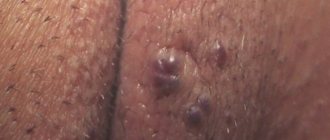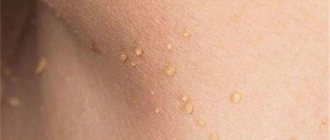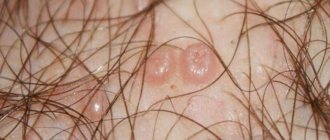Every woman, having discovered a lump on her labia, begins to worry greatly. And first of all, immediately contact a specialist. And this is the right decision. The lump may be painful. In any case, consulting a doctor is necessary, since the cause of this phenomenon may be different. Most often, a lump on the labia can be a symptom of bartholinitis.
Treatment most often involves surgical removal. After removal, antibacterial therapy is mandatory, thereby stopping the further development of the disease.
Lump on the labia
Sometimes it happens that a woman completely unexpectedly notices a subcutaneous lump on her labia majora or minora, most often painful.
It can be a sign of various gynecological diseases, so if you have the slightest suspicion of discomfort or foreign tumors, you should consult a doctor.
In some cases, a lump that appears on the labia may be an ordinary pimple as a local reaction to an external irritant. Over time, this compaction goes away on its own.
The main signs of a rash
Simple acne on the genitals can manifest itself in different ways; they look like nodules, blisters, peculiar bumps and even warts. As a rule, they always protrude on the outside of the skin, but they can also be deep.
Blister-like ulcers protrude on the skin, their density is usually liquid. The color is cloudy or transparent, they may have the color of blood, there is pus inside them and if they are squeezed out, then it is worth treating the skin with alcohol.
Ulcerative erosions remain after squeezed out ulcers, their depth reaches the subcutaneous layer. But if left untreated, the infection can spread to the muscles and bones.
The rash is divided into:
- blisters - urticans,
- maculosis - spotted,
- papular - nodular,
- verrucous - warts,
- ulcers are pustular.
The rashes can be monoform or polyphoric. The former contain only one type of rash, the latter may include two or more types, each of which is clearly visible.
The main causes of seals in the labia
Approximately 8 out of 10 women who consult a gynecologist with a complaint of a lump inside the labia are diagnosed with bartholinitis.
Expert opinion Sakania Luiza Ruslanovna
Dermatovenerologist, cosmetologist, trichologist
Ask a Question
In addition, such a formation may turn out to be a malignant or benign tumor. We will dwell on these diseases in more detail a little later.
However, these are not the only reasons due to which a seal may appear on the labia minora or majora. Also, a similar symptom often occurs in the following cases:
- in some situations, nodular fragments indicate the development of human papillomavirus in a woman’s body. HPV itself quite often passes without consequences, but in certain cases it can provoke cervical cancer, so such changes in the body should be treated very carefully;
- if such a defect appears with enviable regularity before your period, most likely we are talking about an enlarged sebaceous gland, which, upon palpation, is very often mistaken for a dense pimple. Such a disorder in the female body is a consequence of a surge in sex hormones. If after a few days, when the hormonal levels return to normal, the bumps and bumps disappear as suddenly as they appeared, there is nothing to worry about. Meanwhile, some women in such a situation note some discomfort in the genital area. To get rid of unpleasant sensations, try wiping the affected skin with a cotton swab, generously moistened with a soothing and antiseptic tonic. In addition, 1-2 weeks before the start of menstruation, it is useful to give up sweet and fatty foods;
- in rare cases, when small seals on the labia have been present for a very long time and do not bother their owner in any way, they may be the result of abnormal development of the genital organs and, in particular, the labia majora and minora, the urethra and other internal organs and systems. Such formations are not viral or infectious in nature and do not pose any danger to women;
- Finally, even more rarely, compaction in the area of these organs can be noticed in a newborn girl. Almost always, such changes in a baby indicate that both of her parents, or at least one of them, have such a serious disease as syphilis.
When should you not worry about a lump?
When a lump appears on the lip
Due to careless shaving or hair removal, it is not necessary to see a doctor. You can solve the problem yourself, but it is better to consult a cosmetologist.
To get rid of a lump, it is necessary to thoroughly disinfect the surface of the mucous membrane and open the abscess, removing ingrown hair and pus. After this, you will have to carefully monitor the injured area for several days, constantly maintaining cleanliness and sterility.
Blockage of the sebaceous gland and the appearance of a lump also often does not require treatment, but it is still worth identifying the cause of the lump. Often such formations go away on their own, but if pain and discomfort appears when walking, you should not hope for no consequences; the symptom requires treatment.
Bartholinitis
It is necessary to exclude the presence of such a serious gynecological disease in a woman as bartholinitis.
Expert opinion
Sakania Luiza Ruslanovna
Dermatovenerologist, cosmetologist, trichologist
Ask a Question
Bartholinitis is an inflammatory process that occurs in a special Bartholin duct as a result of a sexually transmitted infection, less often in the case of an infection in the tonsils or dental diseases.
If a woman has a lump on her labia, a common reason for this formation is insufficient adherence to the rules of personal hygiene, as a result of which pathogenic pathogens invade the body.
Types and methods of treating cones
Treatment depends on the stage of the disease and its severity. In the acute stage, treatment necessarily includes taking antibiotics or their intramuscular administration to prevent the development of complications. In addition, at the initial stage of the disease the following procedures are recommended:
- applications to the site of the bump with antiseptics;
- sitz baths with a solution of potassium permanganate;
- applications with Levomekol or.
In addition, it is necessary to take medications or vitamins to increase immunity, since the frequency of relapses depends on it. If necessary, painkillers are prescribed for oral or local use. Also necessary are drugs to restore the vaginal microflora, which are used topically in the form of suppositories or capsules.
Seeing a doctor at the abscess stage involves surgery to remove the lump.
The operation is performed under anesthesia and involves opening the abscess, removing all the contents and rinsing with an antibiotic solution. After the operation, complete rest is required, as well as constant stay at a comfortable temperature. In especially severe cases, the lump is removed along with the gland to stop the process of tissue infection.
Symptoms of bartholinitis
If the disease is advanced, then a hard formation on the labia can be quite painful, and a tingling and burning sensation is also felt in the area of the lump.
As a rule, when you press on the seal, the pain intensifies.
In addition, the following symptoms may be observed:
- the seal grows to the size of a chicken egg;
- at the site of compaction, the skin is red, often has a bluish tint;
- there is a high body temperature and fever that antipyretics cannot cope with;
- chills;
- there is a general loss of strength, lethargy, and apathy.
In especially severe cases, the pain reaches such a degree that the woman cannot walk normally.
If the seal on the labia does not prompt the woman to start treatment and consult a doctor, then over time the abscess may spontaneously open. In this case, the woman temporarily experiences relief. However, the disease itself remains, as a result of which relapses may occur in the future.
The disease itself can become chronic, which is more difficult to treat due to its neglect. If the disease progresses, then the formation of a cyst in the area of the labia minora and majora is possible, which requires surgical intervention.
Often the presence of a cyst can make it difficult to perform physiological functions (urination, defecation).
Diseases and infections dangerous to overall health
Bartonilite is usually divided into two types:
- acute form, in which there is severe pain and increased body temperature;
- a chronic form in which pronounced symptoms are replaced by a sluggish course of the disease.
Bartonilitis includes several types of diseases, each of which is characterized by certain symptoms. Depending on the severity, there are three types of bumps on the lip:
- Canaliculitis. In this situation, there is practically no pain, and the canal is not blocked and is able to remove secretions. The excretory duct of the gland is inflamed, causing a lump to appear.
- A false abscess is characterized by inflammation of the canal and the accumulation of a large amount of pus. Pain and discomfort appear, while the tissues remain intact.
- – the most severe form, in which the gland tissue becomes inflamed. In this case, the pain prevents you from moving, constantly reminds you of itself through pulsation, and the lump in this case must be opened surgically in a hospital setting.
It is impossible to independently determine the stage of the disease; only in the case of a true abscess is it difficult to confuse the disease with other variants. The disease can be caused by many other diseases, including:
- infectious diseases;
- staphylococcus, streptococcus, and other microorganisms and bacteria;
- autoimmune disorders;
To get rid of a lump, you will need to not only open it and remove the pus, but also cure the disease that caused the disease.
Diagnosis of the pathological condition
A woman can often detect a lump in the labia on her own, but in order to find out the nature of such a formation, it is still necessary to contact an appropriate specialist, that is, a gynecologist.
During the history taking, the doctor must conduct a gynecological examination of the external genitalia using a special chair and a magnifying mirror.
During this procedure, the doctor evaluates the condition of the pubis, anus, labia minora and labia majora. In addition, the gynecologist pays special attention to the presence of any neoplasms and the structural integrity of the skin in the intimate area.
Expert opinion
Sakania Luiza Ruslanovna
Dermatovenerologist, cosmetologist, trichologist
Ask a Question
The examination is based on palpation (feeling) of the following anatomical structures: the clitoris, the external opening of the urethra, the labia minora, the entrance to the vagina, the anus and the large glands of the vestibule.
If the patient has leucorrhoea (liquid discharge), a sample is additionally taken, after which it is examined under a microscope (cytological examination). If necessary, the uterus and its appendages are examined.
Instrumental diagnostics
Instrumental diagnostic methods are also used to diagnose pathological formations in the vagina. The main ones are:
- lymphography (studying the condition of the nodes of the lymphatic system with the aim of possibly detecting cancer cells in their structure - metastases, which can, along with the bloodstream, enter the lymphatic tissue from other internal organs). The procedure is done using intravenous injection of a contrast agent into the lymphatic vessel. Its movement is then monitored using x-rays;
- ultrasound examination of the pelvis. Today, ultrasound is considered the safest diagnostic technique. During its implementation, the condition of the human genitourinary system is assessed. This procedure has virtually no contraindications and therefore can be used under any circumstances. However, ultrasound scanning is not recommended during menstruation, since at this time the indicators are somewhat distorted, which will significantly complicate further diagnosis;
- computed tomography or magnetic resonance imaging of the pelvic organs. Such diagnostic techniques represent layer-by-layer scanning of anatomical structures and are non-invasive (that is, they do not require direct penetration into the body of the subject through the skin or mucous membranes) and highly accurate procedures. In addition, if the lump on the labia is of a malignant nature, the patient will be prescribed an additional consultation with an oncologist.
Lump as a result of hair removal and other hair removal options
After unsuccessful hair removal, you can also get a lump in the intimate area. This occurs especially often during hair removal, and less often during shaving. When using a razor, the cause may be inaccurate shaving, leading to tissue injury. An infection or other microorganisms may enter the damaged area, causing inflammation and suppuration, blockage of the canal and the appearance of a lump. It is not difficult to avoid this - it is important to immediately treat the damaged area with hydrogen peroxide and avoid getting dirt.
When epilating, the likelihood of bartonylitis occurring is much higher. It appears because the hairs are pulled out from the root and against the growth. In the future, new ones, causing blockage of the canal. The hair follicle begins to become inflamed and pus forms under the skin, causing a painful lump to appear. To prevent this situation, cosmetologists recommend using a scrub during hair regrowth after hair removal.
Diagnostic measures
It is not difficult for a specialist to diagnose condylomas visually. However, in order to understand what caused the appearance of tumors, it is necessary to do a number of tests:
- Blood test for syphilis and immunodeficiency virus.
- Study of the body's immune abilities.
- Biopsy of condyloma tissue.
- Oncological study of condylomas.
- Study of blood for polymerase chain reduction.
An accurate analysis of the causes of condyloma will allow you to prescribe adequate treatment.
Inflammation of hair follicles
Folliculitis occurs after injury to the hair root and infection. This is preceded by careless hair removal or shaving, ingrown hairs. A white or yellow lump with a red, inflamed edge forms on the outer labia. A twisted hair is visible inside. A large pimple is filled with pus and is very painful.
Squeezing it out is extremely dangerous, otherwise harmful bacteria can enter the bloodstream and cause blood poisoning. Treatment consists of wiping the affected area with local antiseptics. To absorb the pus, make compresses with Vishnevsky ointment at night.
Fortunately, almost all diseases, the symptom of which is a ball on the half lips, can be treated. If you see a doctor in time, you can even defeat cancer.
Consequences of missing treatment
At the initial stage, bartonilitis can be easily cured without medical intervention, using available remedies at home. If there is no treatment, the disease will not go away on its own. The abscess will grow, the inflammation will intensify, and eventually you will have to resort to surgery.
Not treating the lump will not work at all - over time the situation will worsen, causing serious discomfort, pain and making it difficult to move. The disease is especially dangerous during the period of bearing a child, when spontaneous opening of an abscess can infect the fetus and cause premature birth or termination of pregnancy.
In especially severe cases, the lack of therapy and the necessary surgical intervention can cause blood poisoning, threatening the woman’s life.









